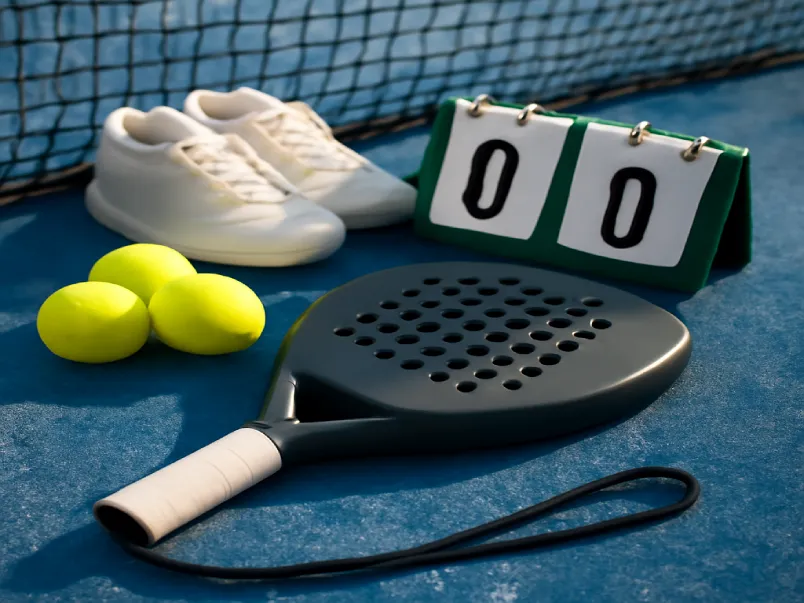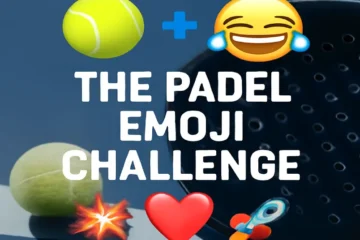The Explosive Growth of Padel
In recent years, a sport has been making waves across the globe, captivating people of all ages and skill levels. It’s fast-paced, fun, and sociable. If you haven’t heard of padel yet, you might be living under a rock, as this tennis-meets-squash hybrid is sweeping through countries like Spain, Argentina, Sweden, and beyond. It’s growing faster than any other sport in the world.
But here’s the twist: Are you truly up to date with the world of padel? Can you answer questions like, “Do you know which famous tennis star co-owns a padel team?” or “What is the ‘golden point’ rule?”
This article is here to test your knowledge, whether you’re a newbie or a seasoned pro. Ready for the ultimate challenge? Let’s dive into some padel trivia!
Section 1: The Origins & History of Padel
To understand padel, we first need to know where it all began. The sport may seem modern, but its roots go back several decades, with a fascinating backstory that makes it all the more exciting.
Trivia Question 1: Where and when was padel invented?
Answer: Padel was invented in 1969 in Acapulco, Mexico.
Trivia Question 2: Who is credited as the inventor?
Answer: Enrique Corcuera is credited with inventing padel.
Trivia Question 3: Why were walls included in the original court?
Answer: Corcuera’s property was too narrow to build a standard tennis court. So, he had the ingenious idea to create walls to prevent the ball from going into his neighbor’s garden, and thus, the idea for a court with walls was born.
Bonus Fact: How did padel spread to Spain and Argentina?
Padel’s spread to Spain and Argentina came in the 1970s. Corcuera’s friend, Spanish aristocrat Alfonso de Hohenlohe, visited Mexico and loved the game so much that he built the first padel courts in Spain. From there, it gained popularity, and by the 1980s, it had crossed the ocean to Argentina, where it became even more popular. Today, Spain and Argentina remain the heartlands of the sport, but its global appeal continues to grow.
Section 2: The Court & Equipment
One of the key things that makes padel so unique is the court and equipment used. Let’s explore how these elements set the sport apart from others.
Trivia Question 4: What are the walls of a padel court made of?
Answer: Padel courts typically have walls made of transparent glass, tempered glass, or concrete blocks, with metallic mesh for the rear walls. This creates a dynamic playing environment where players can use the walls as part of their game strategy.
Trivia Question 5: What is the key physical difference between a padel racket and a tennis racket?
Answer: Unlike tennis rackets, which have strings, padel rackets are solid with perforated holes. They are also shorter, allowing for more control and finesse in shots.
Trivia Question 6: What was the original material used for the first padel rackets?
Answer: The first padel rackets were made of wood, but over time, the sport’s equipment evolved to include more modern materials like fiberglass and carbon fiber, which provide greater strength and durability.
Bonus Fact: What is the purpose of the strap or cord attached to the racket handle?
The strap or cord is there to ensure safety. It prevents the racket from flying out of the player’s hand during intense moments in the game, minimizing the risk of accidents and injuries.
Section 3: Rules & Gameplay
The rules and gameplay in padel have a number of unique aspects that set it apart from other racket sports. Whether you’re familiar with tennis or new to padel, these trivia questions will test how well you know the game.
Trivia Question 7: How is the score kept in padel?
Answer: Just like tennis, padel uses the same scoring system: 15, 30, 40, game. So, if you’re already familiar with tennis, you’ll feel right at home with padel’s scoring.
Trivia Question 8: What is the “Golden Point”?
Answer: The “Golden Point” rule comes into play when the score is tied at 40-40 (deuce). At this point, the receiving team gets to choose which side they want to receive the one, decisive point that will determine the winner of the game.
Trivia Question 9: Name one key service rule that differs from tennis.
Answer: In padel, the serve must be underhand, and the ball must bounce behind the service line but in front of the baseline after being hit. This creates a different dynamic than in tennis, where the serve is overhand and must clear the entire service box.
Trivia Question 10: Can you use the walls after the ball bounces on your side?
Answer: Yes! One of the most exciting aspects of padel is that the ball can bounce off the walls, making for thrilling, fast-paced gameplay. The strategic use of the walls is key to winning many points in padel, and it’s something you won’t find in traditional tennis.
Section 4: The Padel World & Professional Scene
While padel has its roots in casual play, the professional scene has exploded in recent years, drawing top athletes, big sponsors, and a growing audience worldwide. Here’s your chance to see if you’re up-to-date with the sport’s current landscape.
Trivia Question 11: Which legendary tennis player co-owns a professional padel team?
Answer: Rafael Nadal is a famous tennis star who co-owns a professional padel team, showcasing his deep love for the sport.
Trivia Question 12: What is the name of the premier professional padel tour?
Answer: Premier Padel is the premier professional padel tour, which has gained prominence in recent years, largely replacing the former World Padel Tour. The league has become the pinnacle for the sport’s best players.
Trivia Question 13: Which country, besides Spain and Argentina, is a rising powerhouse in padel?
Answer: Sweden is a rising powerhouse in padel. Along with Brazil, Sweden has produced a number of talented players, and the sport is growing rapidly in these countries. The Scandinavian nations are quickly catching up to Spain and Argentina.
Section 5: Fun & Quirky Facts
Let’s wrap up with some lighter, fun trivia that will give you an even deeper appreciation for padel.
Trivia Question 14: What is the nickname for a shot that hits the corner where the wall and the floor meet, making it nearly unreturnable?
Answer: While the “Bandeja” is a commonly used shot in padel, the shot that strikes the corner where the wall and the floor meet is often referred to as a “perfect wall shot.” It’s a near-impossible shot to return due to its placement.
Trivia Question 15: True or False: Padel is considered one of the fastest-growing sports in the world.
Answer: True. Padel is one of the fastest-growing sports globally, and its explosive rise can be attributed to its accessibility, social nature, and exciting gameplay.
Bonus Fact: Padel’s Social Aspect
Padel is often played in doubles, making it a highly social sport. After games, it’s common for players to enjoy a drink, share stories, and bond with each other. This social component is a major draw for people who enjoy both the competitive and communal aspects of sports.
Conclusion: How Did You Score?
Now that you’ve tested your knowledge, it’s time to see how you did! Here’s your official scoring guide:
- 0-5 Correct: Padel Newbie (Welcome to the game!)
- 6-10 Correct: Rising Star (You’re getting the hang of it!)
- 11-14 Correct: Court Champion (You know your stuff!)
- 15 Correct: Padel Guru (You are a true padel expert!)
No matter how many questions you answered correctly, one thing is clear: padel is an exciting, fast-paced sport that’s only going to continue growing. Whether you’re new to the game or a seasoned player, there’s always something new to learn and experience on the court.
So, what are you waiting for? Grab a racket, hit the court, and see for yourself why padel is taking the world by storm.
And don’t forget to share your score and challenge a friend to see if they can top your knowledge!
FAQs
1. What is padel?
Padel is a racket sport that combines elements of tennis and squash, played on a smaller court surrounded by walls. It is typically played in doubles, making it a highly social and fast-paced game. The rules are similar to tennis, but with the added complexity of using the walls as part of the gameplay.
2. Where did padel originate?
Padel was invented in 1969 in Acapulco, Mexico by Enrique Corcuera. It quickly spread to Spain and Argentina, becoming hugely popular in these countries and around the world.
3. What is the “Golden Point” rule in padel?
The “Golden Point” rule comes into play at deuce (40-40). At this point, the receiving team gets to choose which side will receive the decisive point, which will determine the winner of the game. It adds an exciting twist to the game, as one point can decide the outcome.
4. How is padel different from tennis?
While padel shares many similarities with tennis, such as scoring (15, 30, 40), it has key differences. Padel is played on a smaller court, and the ball can bounce off walls. The rackets are solid, perforated, and smaller than tennis rackets, and the serve is underhand, with the ball bouncing behind the service line.
5. Who are the top players in padel?
Some of the top professional padel players include Juan Lebrón, Alejandro Galán, and Paquito Navarro. In addition, Rafael Nadal, the legendary tennis player, has co-owned a professional padel team, showcasing the sport’s growing international appeal.
6. What equipment do I need to play padel?
To play padel, you need a padel racket, which is perforated and solid (without strings). You’ll also need comfortable sportswear and shoes with good grip, as padel is played on a court with walls. The court surface is often artificial grass or a similar material.
7. Can beginners play padel?
Yes! Padel is known for being accessible to players of all skill levels. Whether you’re a complete beginner or an experienced athlete, the game’s rules are easy to grasp, and the social, doubles-based play makes it a great sport for everyone.
8. How is padel growing around the world?
Padel is one of the fastest-growing sports worldwide, especially in countries like Spain, Argentina, Sweden, and Brazil. The sport’s popularity continues to rise due to its accessibility, the social nature of doubles play, and its exciting, fast-paced gameplay.




